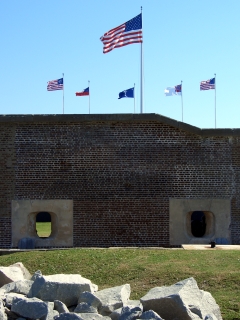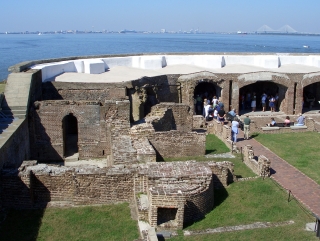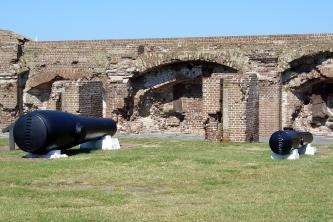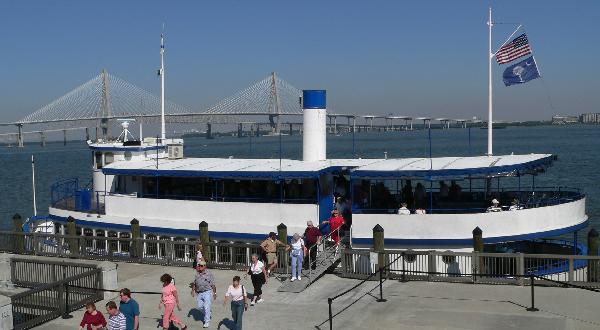NPS Website; Local Website
 WHAT IS IT?
WHAT IS IT?Federal defense fort located in the middle of Charleston Harbor. On April 12, 1861, Confederate troops deluged the Fort with artillery fire, captured the Union soldiers and officially began the American Civil War.
BEAUTY (7/10)
Fort Sumter is a pentagon-shaped redbrick fortification located at the narrowest entry point into Charleston Harbor. The Fort has been largely rebuilt since its major role in American History because non-stop shelling from 1861-65 destroyed its walls and interiors. The Fort, itself, is not particularly attractive especially when compared to the views it affords of the Harbor and old town Charleston.
HISTORICAL INTEREST (7/10)
This is where the Civil War began. Well, at least symbolically. Shortly after Abraham Lincoln’s election, in December of 1860, South Carolina became the first Southern state to secede from the Union. By March 1861, six more states had followed suit. Because they believed themselves to be a new country, the Confederates ordered Federal troops off the Forts within their boundaries.
Even though the American government refused to acknowledge this new nation, they still moved their troops out of most of these Forts. Fort Sumter and Fort Pickens (near Pensacola, Fla.) were the two exceptions. By April 12, three things had happened: 1) Lincoln took office; 2) the Federal troops ran out of supplies and 3) the fiery South Carolinians publicly demanded Sumter’s surrender.
When the Union Major Robert Anderson formally refused to leave, the siege began. Cannon fire rained onto the Fort and less than twelve hours later, Anderson surrendered and the War Between the States had begun. The Confederates held Fort Sumter under General Sherman captured Charleston in 1865.
We asked a Ranger, “How could the Rebels successfully defend Fort Sumter from 1863 to 1865 when the Union made easy work of the similar Fort Pulaski near Savannah.” She sheepishly replied, “Good question: Because they did not have to. Their successful blockade of Charleston Harbor made seizure of Fort Sumter unnecessary.” We added, “So why do the exhibits and the Ranger talks speak about the Fort as the last Confederate stronghold and a symbol of Southern resolve.” Her response was a smile; a spoken answer would have been too complicated.
CROWDS (3/10)
Every day, hundreds of people pile into the ferries that travel to Fort Sumter. The Civil War’s flash point is a major attraction in a major tourist town. The effect is an amusement park experience where most participants are unsure of what they are going to see! We actually overheard this on the ferryboat: “Who knew that historic stuff happened in Charleston?” Fort Sumter feels like a checkmark on the tourists’ Things to Do While Your Cruise Ship is Docked list rather than a pilgrimage to a near-sacred American history destination.
 EASE OF USE/ACCESS (3/5)
EASE OF USE/ACCESS (3/5)We were approached by a very sunburned English man while walking the genteel streets of old town Charlestown. “Could you please point me towards Fort Sumter,” he asked. “You see that island Fort about five miles away?” Michael said while pointing, “That’s Fort Sumter.” “Oh,” he responded, “I am not making it today then, am I?”
Three ferries leave from Liberty Square/Aquarium throughout most of the year. Liberty Square borders the Cooper River, the Charleston peninsula’s eastern coast, and stands at the end of Calhoun Street. As for driving directions, look for signs to the Aquarium.
Charleston peninsula is all narrow one-way streets and few long-term non-parking garage options. We walked from our hotel. Most of the other visitors had walked from their cruise ship docked nearby.
A far more accessible ferry leaves from Patriot’s Point in Mount Pleasant. Patriot’s Point has ample free parking and only slightly less frequent service. Three boats leave during the summer, two during spring and fall and one during winter.
CONCESSIONS/BOOKSTORE (3/5)
Civil War bookstores set a high standard because most overflow with hundreds of obscure tomes and kitschy knickknacks. Fort Sumter does not live up to this difficult scrutiny. You are not going to find a long lost Civil War text here. A few books, however, did catch our eye, including Dr. Seuss Goes to War, an eye-opening book that recounts the children’s book writer’s early career as an editorial cartoonist for The New Yorker magazine during World War II.
COSTS (1/5)
Fort Sumter stands in the middle of Charleston Harbor. You need to take a ferry. The boat’s 2005 rates were $13 per adult. If you take the Liberty Square ferry, you need to use a parking garage. Metered street parking is capped at two hours, the round trip to Fort Sumter lasts for two hours and 15 minutes. Coincidence?
RANGER/GUIDE TO TOURIST RATIO (2/5)
The ferryboats dropped at least 100 fellow tourists and us off on the Island for one hour. During that period, one Ranger gave a 30-minute talk about the Fort. Once his talk finished, another Ranger appeared to answer questions and the lecturer disappeared.
For much of our visit, we fruitlessly tried to corner one of the Rangers. We had questions but so did countless other patrons. We were not able to isolate a Ranger until five minutes before departure. We left disappointed and wishing for more staffing at this highly visited marquee historic attraction.
TOURS/CLASSES (4/10)
 The Fort Sumter Ranger talk and ferry boat narration are an elementary-school level Civil War refresher course. The teaching is aimed at the lowest common denominator; understandable when you see thousands of tour boat travelers every day but disappointing for history nerds like us. The good news is that the Rangers really know their stuff. The bad news is that you might have trouble getting you questions answered given the large crowds.
The Fort Sumter Ranger talk and ferry boat narration are an elementary-school level Civil War refresher course. The teaching is aimed at the lowest common denominator; understandable when you see thousands of tour boat travelers every day but disappointing for history nerds like us. The good news is that the Rangers really know their stuff. The bad news is that you might have trouble getting you questions answered given the large crowds.We enjoyed the Park’s two Museums, especially the one located in Liberty Square. The Liberty Square Museum approaches the events leading up to the events of April 1861, the South Carolinian mess of human rights, property rights and states rights. In another word: slavery. Be sure to take the time to read its intelligent but carefully worded displays, especially the Ambiguities of the Constitution exhibit.
Most tourists seemed to skip the Museum altogether on their way from the ticket booth to the ferry queue. Do not be that person. The Museum provides a terrific and in-depth intro to the Civil War. Do not rely on the inane canned historical nuggets provided over the ferryboat’s antiquated audio system. The second Museum, located on Fort Sumter, examines the Fort’s role during the War.
FUN (5/10)
Island Park sites are difficult. Ferryboat rides are expensive and your time is always limited. We tend to spend multiple hours at forts and battlefields between the museums and Ranger talks. Fort Sumter does not allow you to learn at your own pace. Our visit felt very rushed. One hour was not enough. However, the one-hour Harbor cruise was nice; Charleston, S.C. is one of America’s most beautiful old cities and the views from the water are spectacular.
WOULD WE RECOMMEND? (5/10)
We loved our time in Charleston and Fort Sumter is its most essential tourist attraction. Oddly, though, it was the low point of our visit to the Holy City. The trip was more obligatory than fun. Sumter’s best learning opportunities are found at the landlocked Museum and experienced without the ferry ride. Time spent on the fort is time not spent on the old town streets, at the boutique shops and in the terrific restaurants. So should you go? Er, uh, ah, um, probably yes.
TOTAL 40/80
www.usa-c2c.com
© 2004-2006
